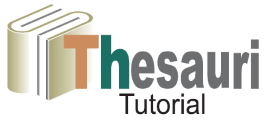Terms in thesauri are the verbal form we use to describe a concept. Each term should represent only one concept. As thesaurus is designed to represent knowledge in a certain domain of discourse, each of the terms they contains should be defined in such a way so that their meaning is restricted within the scope of this domain. For this reason, when building a thesaurus we should take care to clarify homographs, words that have the same spelling but can have different meanings (e.g. A bat can be a piece of sports equipment an animal.) and terms whose meaning overlap.
The following rules should be applied in order to disambiguate homographs:
- Use a brief qualifier in parentheses or in italics with each homograph to clarify their meaning. The qualifier ideally should consist of only one word.
Example: cranes (birds), cranes (lifting equipment) - Alternatively, prefer a multi-word term instead of a single-word term, if the compound form occurs in natural language.
Example: use the term. "industrial plants" instead of "plants (facilities)". - The qualifier may be left out if only one of the homographic terms is used and its meaning is obvious to the users of the thesaurus. However, the creator of the thesauri should take into account the possibility that the thesaurus scope may be expanded in the future, or that interoperability with other vocabularies covering different scopes might be needed.
- In the case of acronyms and abbreviations the qualifier should be the full form of the term





